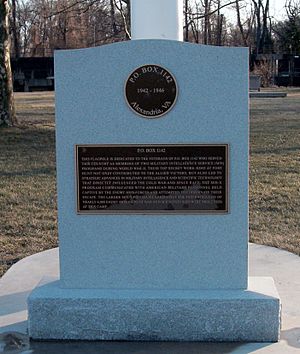P. O. Box 1142 facts for kids
P.O. Box 1142 was a top-secret American military base during World War II. It was a special place where the United States gathered important information. This secret facility operated from 1942 to 1946.
The American Military Intelligence Service had two main parts. One part was called MIS-X. It helped Prisoners of War (POWs) held in Europe escape. The other part was MIS-Y. Its main job was to talk to captured enemy soldiers.
MIS-Y used the codename "P.O. Box 1142." This was their secret mailing address. Many of the people who questioned prisoners were Jewish immigrants. They had left Germany when they were children. They were chosen because they knew German language and culture very well. They also wanted to help defeat the Nazis.
P.O. Box 1142 was located at Fort Hunt in Virginia. This land used to be part of George Washington's farms. German scientists, submarine crews, and soldiers were brought here. The base gathered valuable information from these German POWs. It also helped communicate with Allied POWs overseas.
The camp did not follow some rules of the Geneva Convention. For example, the Red Cross was not told about the prisoners' location. However, people who worked there said that torture was not used.
The work done at Fort Hunt was very important. It helped the Allies win World War II. It also led to new scientific and military discoveries. These discoveries later influenced the Cold War. In 1946, the camp's buildings were torn down. Its existence was kept secret until the early 2000s. The National Park Service then shared parts of the fort's history. In 2007, former intelligence workers met there. A flagpole and a plaque were put up to honor their contributions.
What Was Operation Paperclip?
P.O. Box 1142 was one of several secret places. The United States used them to learn from German scientists. This was part of a plan called Operation Paperclip. The goal was to stop these scientists from helping the Soviet Union. The U.S. wanted to get their knowledge first.
The Joint Intelligence Objectives Agency led this operation. They were very interested in scientists who worked on Hitler's V2 Rocket program. These rockets were advanced weapons. The U.S. wanted to use this knowledge for its own defense.
How Prisoners Were Questioned
Over time, more information about P.O. Box 1142 has become public. This is because former guards and questioners are getting older. Also, secret documents have been released. Between 1942 and 1946, over 3,400 prisoners were questioned. More than 500 of them were scientists from Operation Paperclip.
During these interviews, a lot was learned about German technology. This included advances in rockets, jet engines, and weapons. They also learned about special torpedoes. The United States used this information. For example, they developed ways to stop the German torpedoes.
Former questioners said they did not use physical harm. Instead, they used clever psychological tricks. For example, they might threaten to send a prisoner to the Soviet NKVD. This was a scary thought for many Germans.
National Park Service Ranger Brandon Bies interviewed over 70 former workers. He said, "To our knowledge, no. There was no torture here. This is a question that was asked in every interview the National Park Service conducted, and we have found no evidence that there was anything remotely resembling torture that happened here."
Russian American soldiers Alex Schidlovsky and Alexander Dallin would dress in Russian uniforms and they would attend the interrogations. We would play good cop, bad cop. If you want to talk, okay you can go to a nice POW camp in Fort Meade. Otherwise, you could go to the Soviet Union. And guess what they preferred?
—Rudy Pins, interrogator at Fort Hunt
During the many interrogations, I never laid hands on anyone. We extracted information in a battle of the wits. I'm proud to say I never compromised my humanity.
—George Frenkel, US interrogator
Images for kids


